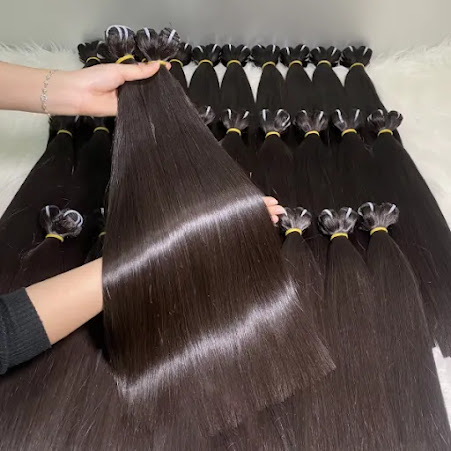Raw Hair vs. Remy Hair vs. Non-Remy Hair: Which One is Right for You?
Choosing the best type of hair extension might be difficult with so many varieties available. Is it better to get non-remy hair, remy hair, or raw hair?
From the opulent texture of unprocessed raw hair to the cost-effectiveness of non-remy hair, each type has unique advantages. Your preferred style, budget, and how long you expect your extensions to last will all influence your decision. We'll compare these three hair kinds in this article to assist you in selecting the one that best suits your needs.
What is Raw Hair?
Raw hair is the most natural and unprocessed type of hair available. It is collected directly from a single donor and has not undergone any chemical treatments, steaming, or processing. Because it remains in its purest state, raw hair retains its natural texture, strength, and durability.
Characteristics of Raw Hair:
No chemical treatments (no dye, steam processing, or coatings).
Maintains natural texture (curly, straight, or wavy).
Thick, strong cuticles that ensure durability.
Pros of Raw Hair:
Long-lasting (can last for years with proper care).
Can be dyed, styled, and treated like natural hair.
Minimal shedding and tangling due to intact cuticles.
Cons of Raw Hair:
More expensive than other hair types.
Limited availability and fewer uniform textures.
What is Remy Hair?
Remy hair is one of the most popular choices for hair extensions due to its high quality and affordability compared to raw hair. The defining characteristic of remy hair is that all cuticles are intact and aligned in the same direction. This alignment helps prevent tangling and ensures a smooth, natural flow.
Characteristics of Remy Hair:
Collected from a donor with careful cuticle preservation.
May undergo minimal processing (such as steam treatment for uniform curls).
Smooth and tangle-free due to aligned cuticles.
Pros of Remy Hair:
More affordable than raw hair but still high-quality.
Natural-looking with good longevity (6 months to a year).
Minimal tangling and matting compared to non-remy hair.
Cons of Remy Hair:
Slightly processed, so not as natural as raw hair.
May not last as long as raw hair with frequent styling.
What is Non-Remy Hair?
Non-remy hair is a budget-friendly alternative that is widely available but tends to have a shorter lifespan. Unlike remy hair, non-remy hair is collected from multiple sources, such as salon floors or hairbrushes, which means the cuticles are not aligned in the same direction.
Characteristics of Non-Remy Hair:
Cuticles face different directions, leading to tangling.
Often chemically treated and coated with silicone for a smooth appearance.
Usually sourced from hairbrushes, salon floors, or mixed collections.
Pros of Non-Remy Hair:
Most affordable option for temporary styles.
Available in a wide range of textures and colors.
Cons of Non-Remy Hair:
Short lifespan due to tangling and shedding.
Silicone coating wears off quickly, making hair look dull.
Not as natural-looking or durable as remy or raw hair.
Raw Hair, Remy Hair, and Non Remy Hair: Which One Should You Choose?
Budget, durability, and quality are important considerations while choosing hair extensions. The most natural choice is raw hair, which is taken from a single donor and isn't treated with chemicals. Although it is the most expensive, it is long-lasting, tangle-free, and durable because it maintains its cuticle alignment. Remy hair has a smooth, natural appearance and is a high-quality, slightly processed substitute with aligned cuticles. It is a fantastic mid-range alternative because it is easy to style, less expensive than raw hair, and resistant to tangles.
The most affordable option is non-remy hair, but its cuticles are not aligned, which causes matting and tangling. It is frequently chemically treated and silicone-coated, although the coating peels off over time, reducing its longevity. Although it works well for temporary applications, it is not as durable as raw or remy hair. Raw hair is the best option if you want premium quality; remy hair is the best option if you want price and durability in balance; and non-remy hair can be a good short-term, inexpensive option. After all, it all depends on your personal preferences.
Conclusion
By understanding these key differences between raw hair, remy hair, and non-remy hair, you can make an informed decision when purchasing hair extensions, ensuring you get the best value for your investment.





Comments
Post a Comment